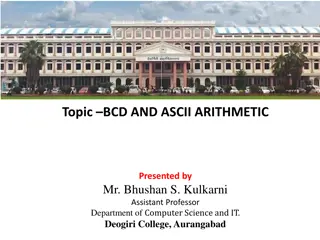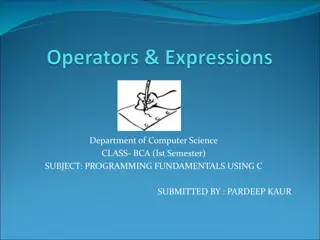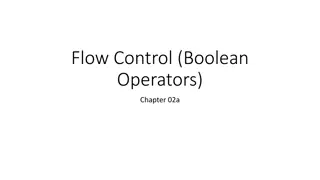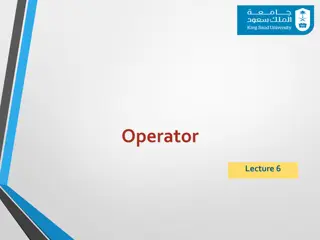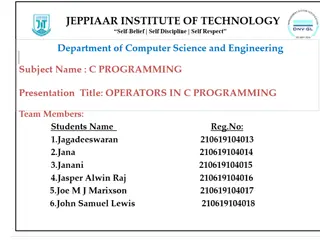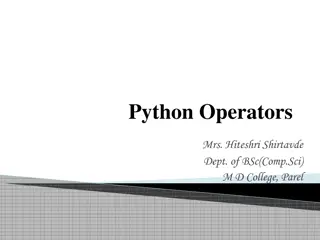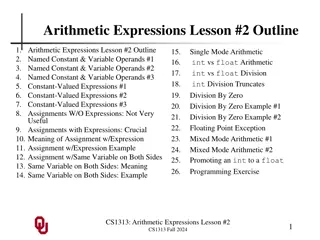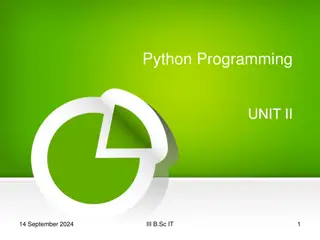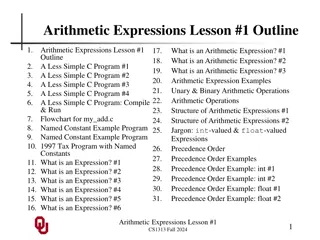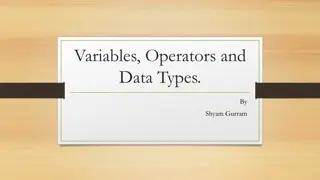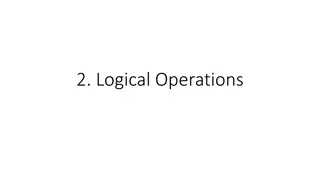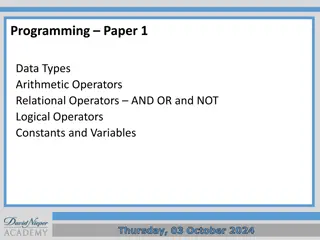Understanding Arithmetic Operators in C Programming
C programming language provides various arithmetic operators such as addition, subtraction, multiplication, division, and modulo division. Integer division truncates any fractional part, while modulo division produces the remainder of an integer division. When operands in an arithmetic expression are integers, it is referred to as integer arithmetic, always yielding an integer value. Examples of arithmetic operations include addition, subtraction, multiplication, division, and modulo division. The usage and constraints of these operators are explained with practical examples.
Download Presentation

Please find below an Image/Link to download the presentation.
The content on the website is provided AS IS for your information and personal use only. It may not be sold, licensed, or shared on other websites without obtaining consent from the author. Download presentation by click this link. If you encounter any issues during the download, it is possible that the publisher has removed the file from their server.
E N D
Presentation Transcript
OPERATORS OPERATORS in in C Programming C Programming Dr. P. Lawrence Dr. P. Lawrence Rozario Assistant Professor, Assistant Professor, Department of Mathematics, Department of Mathematics, St. Joseph s College St. Joseph s College Trichirappalli Trichirappalli 620 002, Tamil Nadu, India. Tamil Nadu, India. lawraj2006@yahoo.co.in lawraj2006@yahoo.co.in Rozario Raj Raj 620 002,
OPERATORS OPERATORS IN IN C C P PROGRAMMING ROGRAMMING C C supports supports a a rich rich set set of of operators operators. . An An operator operator is is a a symbol computer computer mathematical mathematical or symbol that perform perform or logical logical manipulations manipulations. . that tells tells the certain certain the to to Operators Operators are manipulate manipulate are used data data used in in programs and and programs to variables variables. . to
C operators can be classical into C operators can be classical into 1. Arithmetic operators. 1. Arithmetic operators. 2. Relational operators. 2. Relational operators. 3. Logical operators. 3. Logical operators. 4. Assignment operators. 4. Assignment operators. 5. Increment operators. 5. Increment operators. 6. Conditional operators. 6. Conditional operators. 7. Bitwise operators. 7. Bitwise operators. 8. Special operators. 8. Special operators.
1. ARITHMETIC OPERATORS 1. ARITHMETIC OPERATORS C provides all the basic arithmetic operators. C provides all the basic arithmetic operators. Operator Operator Meaning Meaning + + - - * * / / % % Addition or unary plus Addition or unary plus Subtraction or unary minus Subtraction or unary minus Multiplication Multiplication Division Division Modulo division Modulo division
Integer division truncates any fractional part. The modulo division Integer division truncates any fractional part. The modulo division produces the remainder of an integer division. produces the remainder of an integer division. Integer Arithmetic Integer Arithmetic When both the operands in a single arithmetic expression such as When both the operands in a single arithmetic expression such as a+b are integers, the expression is called an integer expression, and the are integers, the expression is called an integer expression, and the operation is called integer arithmetic. Integer arithmetic always yield operation is called integer arithmetic. Integer arithmetic always yield an integer value. an integer value. a+b Examples of arithmetic operators are: Examples of arithmetic operators are: Here a and b are variables and are known as operands. The modulo Here a and b are variables and are known as operands. The modulo division operator % cannot be used on floating point data. division operator % cannot be used on floating point data. a a b b a * b a * b a % b a % b a + b a + b a / b a / b - -a * b a * b a = 14 and b = 4 then a a = 14 and b = 4 then a b = 10 , a + b = 18, a * b = 56, a / b = 3 b = 10 , a + b = 18, a * b = 56, a / b = 3 (decimal part truncated) , a % b = 2 (remainder of division) (decimal part truncated) , a % b = 2 (remainder of division)
Real Arithmetic Real Arithmetic An arithmetic operation involving only real operands is called real An arithmetic operation involving only real operands is called real arithmetic. A real operand may assume values either in decimal or arithmetic. A real operand may assume values either in decimal or exponential notation. Since floating point values are rounded to the exponential notation. Since floating point values are rounded to the number of significant digits permissible, the final value is an number of significant digits permissible, the final value is an approximation of the correct result. If x, y, and z are floats, then we approximation of the correct result. If x, y, and z are floats, then we will have; will have; x = 6.0/7.0 = 0.857143 x = 6.0/7.0 = 0.857143 y = 1.0/3.0 = 0.333333 y = 1.0/3.0 = 0.333333 z = z = - -2.0/3.0 = 2.0/3.0 = - - 0.666667 the operator % cannot be used with real operands. the operator % cannot be used with real operands. 0.666667 Mixed Mixed- -mode Arithmetic mode Arithmetic When one of the operands is real and the other is integer, the When one of the operands is real and the other is integer, the expression is called a mixed expression is called a mixed- -mode arithmetic expression. If either mode arithmetic expression. If either operand is of the real type, then only the real operation is performed operand is of the real type, then only the real operation is performed and the result is always a real number. and the result is always a real number. Thus Thus 15/10.0 = 1.5 15/10.0 = 1.5 Where as Where as 15/10 = 1 15/10 = 1
2. RELATIONAL OPERATORS 2. RELATIONAL OPERATORS Comparisons can be done with the help of relational operators. Comparisons can be done with the help of relational operators. Relational Operators Relational Operators Operator Operator Meaning Meaning < < <= > > >= = = ! = ! = is less than is less than is less than or equal to is less than or equal to is greater than is greater than is greaten than or equal to is greaten than or equal to is equal to is equal to is not equal to is not equal to <= >= = =
A simple relational expression contains only one relational A simple relational expression contains only one relational operator and takes the following from: operator and takes the following from: ae ae 1 relational operator ae 1 relational operator ae- -2 2 ae ae- -1 1 relational operator ae relational operator ae- -2 2 ae ae- -1 and ae 1 and ae- -2 are arithmetic expressions. Which may be simple 2 are arithmetic expressions. Which may be simple constants, variables or combination of them. constants, variables or combination of them. Examples of simple relational expressions and their values: Examples of simple relational expressions and their values: 4.5 <= 4.5 <= 10 10 4.5 < 4.5 < - -10 10 When arithmetic expressions are used on either side of a relational When arithmetic expressions are used on either side of a relational operator, the arithmetic expressions will be evaluated first and then operator, the arithmetic expressions will be evaluated first and then the results compared. That is, arithmetic operators have a higher the results compared. That is, arithmetic operators have a higher priority over relational operators. priority over relational operators. Relational expressions are used in decision statements such Relational expressions are used in decision statements such as, if and while to etc. as, if and while to etc. TRUE TRUE FALSE FALSE
3. LOGICAL OPERATORS 3. LOGICAL OPERATORS C has the following three logical operators. C has the following three logical operators. & & meaning & & meaning || meaning || meaning ! meaning ! meaning logical AND logical AND logical OR logical OR logical NOT logical NOT The logical operators && and are used when we want to test The logical operators && and are used when we want to test more than one condition and make decisions. more than one condition and make decisions. Example : Example : relational expressions is termed as a logical expression or a relational expressions is termed as a logical expression or a compound relational expression. compound relational expression. An expression of this kind which combines two or more An expression of this kind which combines two or more a > b && x = = 10 a > b && x = = 10
The logical expression given above is true only if a>b is The logical expression given above is true only if a>b is true and x = = 10 is true. If either (or both) of them are false, the true and x = = 10 is true. If either (or both) of them are false, the expression is false. expression is false. Truth Table Truth Table Value of t he express ion op op- -1 1 op op- -2 2 op-1 && op -2 op- 1 ||op-2 Example: Example: Non Non- -zero Non Non- -zero 0 0 0 0 zero zero Non Non- -zero 0 0 Non Non- -zero 0 0 zero 1 1 0 0 0 0 0 0 1 1 1 1 1 1 0 0 zero if (age > 55 && salary < 1000) if (age > 55 && salary < 1000) if (number < 0 number > 100) if (number < 0 number > 100)
4. ASSIGNMENT OPERATORS 4. ASSIGNMENT OPERATORS Assignment operators are used to assign the result of an expression to a Assignment operators are used to assign the result of an expression to a variable. We have seen the usual assignment operator, = . In addition, C variable. We have seen the usual assignment operator, = . In addition, C has a set of shorthand assignment operators of the form has a set of shorthand assignment operators of the form v op = exp v op = exp Where v is a variable, exp is an expression and op is a C binary Where v is a variable, exp is an expression and op is a C binary arithmetic operator. The operator op = is known as the shorthand arithmetic operator. The operator op = is known as the shorthand assignment operator. assignment operator. The assignment statement The assignment statement v op = exp; v op = exp; is equivalent to is equivalent to v = v op (exp); v = v op (exp); with v evaluated only once. with v evaluated only once. Consider an example Consider an example This is same as the statement This is same as the statement The shorthand operator + = means add y+1 to x or increment x by y+1 . The shorthand operator + = means add y+1 to x or increment x by y+1 . For y = 2, the above statement becomes For y = 2, the above statement becomes x + = 3; x + = 3; and when this statement is executed, 3 is added to x. If the old value of x and when this statement is executed, 3 is added to x. If the old value of x is, say 5, then the new value of x is 8. is, say 5, then the new value of x is 8. x + = y + 1 x + = y + 1 x = x + (y + 1); x = x + (y + 1);
Statement with simple Statement with simple Assignment operator Assignment operator Shorthand Assignment Operators Shorthand Assignment Operators Statement with Statement with shorthand operator shorthand operator a = a + 1 a = a + 1 a = a a = a 1 1 a = a * (n +1) a = a * (n +1) a = a / (n +1) a = a / (n +1) a = a % b a = a % b a + = 1 a + = 1 a a - - = 1 = 1 a * = n+1 a * = n+1 a / = n + 1 a / = n + 1 a % = b a % = b The use of shorthand assignment operators has three advantages: The use of shorthand assignment operators has three advantages: and therefore it becomes easier to write. and therefore it becomes easier to write. 2. The statement is more concise and easier to read. 2. The statement is more concise and easier to read. 3 The statement is more efficient. 3 The statement is more efficient. 1 What appears on the left 1 What appears on the left- -hand side need not be repeated hand side need not be repeated
5. INCREMENT AND DECREMENT OPERATORS 5. INCREMENT AND DECREMENT OPERATORS C has two very useful operators not generally found in other C has two very useful operators not generally found in other language. language. These are the increment and decrement operators: These are the increment and decrement operators: + + and + + and - - - - The operator + + adds 1 to the operand while The operator + + adds 1 to the operand while - - - - subtracts 1. Both are unary operators and take the following form: are unary operators and take the following form: + +m; or m + +; + +m; or m + +; - - - - m; or m m; or m - - - -; ; + +m; is equivalent to m = m + 1; (or m + = 1;) + +m; is equivalent to m = m + 1; (or m + = 1;) - - - - m; is equivalent to m = m m; is equivalent to m = m 1; (or m We use the increment and decrement statements in for and while We use the increment and decrement statements in for and while loops extensively. loops extensively. While + + m and m + + mean the same thing when they from While + + m and m + + mean the same thing when they from statements independently, they behave differently when they are statements independently, they behave differently when they are used in expressions on the right used in expressions on the right- -hand side of an assignment hand side of an assignment statement. statement. subtracts 1. Both 1; (or m - - = 1;) = 1;)
Consider the following: Consider the following: In this case, the value of y and m would be 6. Suppose, if we In this case, the value of y and m would be 6. Suppose, if we rewrite the above statements as rewrite the above statements as m = 5; m = 5; y = m ++; y = m ++; then, the value of y would be 5 and m would be 6. then, the value of y would be 5 and m would be 6. m = 5; m = 5; y = + +m; y = + +m; A prefix operator first adds 1 to the operand and then the result is A prefix operator first adds 1 to the operand and then the result is assigned to the variable on left. On the other hand, a postfix assigned to the variable on left. On the other hand, a postfix operator first assigns the value to the variable on left and then operator first assigns the value to the variable on left and then increments the operand. increments the operand.
6. CONDITIONAL OPERATOR 6. CONDITIONAL OPERATOR A ternary operator pair ?: is available in C to construct conditional A ternary operator pair ?: is available in C to construct conditional expressions of the form expressions of the form exp1? exp2 : exp3; exp1? exp2 : exp3; where exp1, exp2, and exp3 are expressions: where exp1, exp2, and exp3 are expressions: is nonzero (true), then the expression exp2 is evaluated and becomes is nonzero (true), then the expression exp2 is evaluated and becomes the value of the expression. If exp1 is false, exp3 is evaluated and its the value of the expression. If exp1 is false, exp3 is evaluated and its value becomes the value of the expression. Note that only one of the value becomes the value of the expression. Note that only one of the expressions (either exp2 or exp3) is evaluated. expressions (either exp2 or exp3) is evaluated. The operator ? : works as follows : The operator ? : works as follows : exp1 is evaluated first. If it exp1 is evaluated first. If it Example : Example : a = 10; a = 10; b = 15; b = 15; x = (a>b) ? a : b; then x = 15. x = (a>b) ? a : b; then x = 15.
7 . BITWISE OPERATORS 7 . BITWISE OPERATORS C has a distinction of supporting special operators known as bitwise C has a distinction of supporting special operators known as bitwise operators for manipulation of data at bit level. These operators are operators for manipulation of data at bit level. These operators are used for testing the bits, or shifting them right or left. Bitwise used for testing the bits, or shifting them right or left. Bitwise operators may not be applied to float or double. operators may not be applied to float or double. Bitwise Operators Bitwise Operators Operator Operator & & | | ^ ^ << << >> >> ~ ~ Meaning Meaning bitwise AND bitwise AND bitwise OR bitwise OR Bitwise exclusive OR Bitwise exclusive OR shift left shift left shift right shift right One s complement One s complement
8 . SPECIAL OPERATORS 8 . SPECIAL OPERATORS C supports some special operators of interest such as C supports some special operators of interest such as comma operator, comma operator, sizeof sizeof operator, pointer operators (& and *) operator, pointer operators (& and *) and member selection operators (.and and member selection operators (.and - ->) and preprocessor operators (# and ##). operators (# and ##). >) and preprocessor The Comma Operator The Comma Operator The comma operator can be used to link the related The comma operator can be used to link the related expressions together. A comma expressions together. A comma- -linked list of expressions are evaluated left to right and the value of right evaluated left to right and the value of right- -most expression is the value of the combined expression. the value of the combined expression. linked list of expressions are most expression is Example: Example: value = (x = 10, y = 5, value = (x = 10, y = 5, x+y For (n=1, m = 10; n<=m; n ++, m ++) For (n=1, m = 10; n<=m; n ++, m ++) x+y); );
The The sizeof sizeof Operator The The sizeof sizeof is a compile time operator and, when used is a compile time operator and, when used eith it returns the number of bytes the operand occupies. The operand it returns the number of bytes the operand occupies. The operand may be a variable, a constant or a data type qualifier. may be a variable, a constant or a data type qualifier. Operator eith an operand, an operand, Examples: Examples: The The sizeof sizeof operator is normally used to determine the lengths of operator is normally used to determine the lengths of arrays and structures when their sizes are not known to the arrays and structures when their sizes are not known to the programmer. It is also used to allocate memory space dynamically to programmer. It is also used to allocate memory space dynamically to variables during execution of a program. variables during execution of a program. m = m = sizeof sizeof(sum); n = n = sizeof sizeof(long k = k = sizeof sizeof(235L); (sum); (long int (235L); int); );



